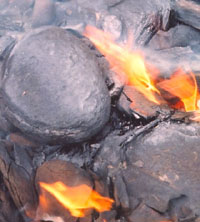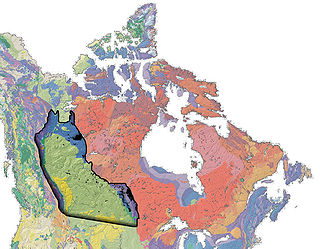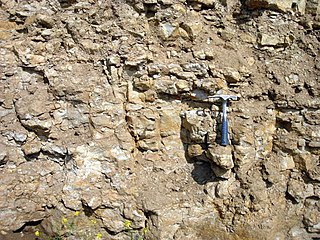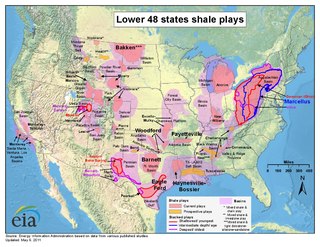Geographical allocation
There is no comprehensive overview of oil shale geographical allocation around the world. Around 600 known oil shale deposits are diversely spread throughout the earth, and are found on every continent with the possible exception of Antarctica, which has not yet been explored for oil shale. [3] [10] Oil shale resources can be concentrated in a large confined deposit such as the Green River formations, which were formed by a large inland lake. These can be many meters thick but limited by the size of the original lake. They may also resemble the deposits found along the eastern American seaboard, which were the product of a shallow sea, in that they may be quite thin but laterally expansive, covering thousands of square kilometers.
| Deposit | Country | Period | In-place shale oil resources (million barrels) | In-place oil shale resources (million metric tons) |
|---|---|---|---|---|
| Green River Formation | United States | Paleogene | 1,466,000 | 213,000 |
| Phosphoria Formation | United States | Permian | 250,000 | 35,775 |
| Eastern Devonian | United States | Devonian | 189,000 | 27,000 |
| Heath Formation | United States | Early Carboniferous | 180,000 | 25,578 |
| Olenyok Basin | Russia | Cambrian | 167,715 | 24,000 |
| Congo | Democratic Republic of Congo | ? | 100,000 | 14,310 |
| Irati Formation | Brazil | Permian | 80,000 | 11,448 |
| Sicily | Italy | ? | 63,000 | 9,015 |
| Tarfaya | Morocco | Cretaceous | 42,145 | 6,448 |
| Volga Basin | Russia | ? | 31,447 | 4,500 |
| Leningrad deposit, Baltic Oil Shale Basin | Russia | Ordovician | 25,157 | 3,600 |
| Vychegodsk Basin | Russia | Jurassic | 19,580 | 2,800 |
| Wadi Maghar | Jordan | Cretaceous | 14,009 | 2,149 |
| Graptolitic argillite | Estonia | Ordovician | 12,386 | 1,900 |
| Timahdit | Morocco | Cretaceous | 11,236 | 1,719 |
| Collingwood Shale | Canada | Ordovician | 12,300 | 1,717 |
| Italy | Italy | Triassic | 10,000 | 1,431 |
The table below reports reserves by estimated amount of shale oil. Shale oil refers to synthetic oil obtained by heating organic material (kerogen) contained in oil shale to a temperature which will separate it into oil, combustible gas, and the residual carbon that remains in the spent shale. All figures are presented in barrels and metric tons.
| Region | In-place shale oil resources (million barrels) | In-place oil shale resources (million metric tons) | Production in 2008 (thousand metric tons (oil)) |
|---|---|---|---|
| Africa | 159,243 | 23,317 | - |
| Democratic Republic of the Congo | 100,000 | 14,310 | - |
| Morocco | 53,381 | 8,167 | - |
| Asia | 613,145 | 83,836 | 375 |
| China | 354,430 | 47,600 | 375 |
| Pakistan | 91,000 | 12,236 | - |
| Russia | 167,715 | 24,000 | - |
| Europe | 368,156 | 52,845 | 355 |
| Russia | 247,883 | 35,470 | - |
| Italy | 73,000 | 10,446 | - |
| Estonia | 16,286 | 2,494 | 355 |
| Middle East | 38,172 | 5,792 | - |
| Jordan | 34,172 | 5,242 | - |
| North America | 3,722,066 | 539,123 | - |
| United States | 3,706,228 | 536,931 | - |
| Canada | 15,241 | 2,192 | - |
| Oceania | 31,748 | 4,534 | - |
| Australia | 31,729 | 4,531 | - |
| South America | 82,421 | 11,794 | 157 |
| Brazil | 82,000 | 11,734 | 159 |
| World total | 4,786,131 | 689,227 | 930 |
Africa
Major oil shale deposits are located in the Democratic Republic of Congo (equal to 14.31 billion metric tons of shale oil) and Morocco (12.3 billion metric tons or 8.16 billion metric tons of shale oil). Deposits in Congo are not properly explored yet. [7] In Morocco, oil shale deposits have been identified at ten localities with the largest deposits in Tarfaya and Timahdite. Although reserves in Tarfaya and Timahdit are well explored, the commercial exploitation has not started yet and only a limited program of laboratory and pilot-plant research has been undertaken. [16] There are also oil shale reserves in Egypt, South Africa, Madagascar, and Nigeria. The main deposits of Egypt are located in Safaga-Al-Qusayr and Abu Tartour areas. [7]
Asia
Major oil shale deposits are located in China, which has an estimated total of 32 billion metric tons, of which 4.4 billion metric tons are technically exploitable and economically feasible. [7] [5] In 2008, the amount of potential shale oil was estimated at 354 billion barrels (5.63×1010 cubic metres) and in 2016 at 330 billion barrels (5.2×1010 cubic metres). [15] [14] The principal Chinese oil shale deposits and production lie in Fushun and Liaoning; others are located in Maoming in Guangdong, Huadian in Jilin, Heilongjiang, and Shandong. [5] Professor Alan R. Carroll of University of Wisconsin–Madison estimates that Upper Permian lacustrine oil shale deposits of northwest China, absent from previous global oil shale assessments, are comparable to the Green River Formation. [17]
In addition to China, major deposits are located in Thailand (18.7 billion metric tons), Pakistan (227 billion metric tons, of which 9.1 billion metric tons are technically exploitable and economically feasible), Kazakhstan (several deposits; major deposit at Kenderlyk Field with 4 billion metric tons), and Turkey (2.2 billion metric tons). [6] [7] Thailand's oil shale deposits are near Mae Sot, Tak Province, and at Li, Lamphun Province. [18] Deposits in Turkey are found mainly in middle and western Anatolia. [7] According to some reports, also Uzbekistan has major oil shale deposits of 47 billion metric tons, mainly located at Sangruntau but also at Baysun, Jam, Urtabulak, Aktau, Uchkyr and Kulbeshkak. [19] Smaller oil shale reserves have also been found in India, Turkmenistan, Myanmar, Armenia, and Mongolia.
Europe

The biggest oil shale reserves in Europe are located in Russia (equal to 35.47 billion metric tons of shale oil). Major deposits are located in the Volga-Petchyorsk province and in the Baltic Oil Shale Basin. Other major oil shale deposits in Europe are located in Italy (10.45 billion metric tons of shale oil), Estonia (2.49 billion metric tons of shale oil), France (1 billion metric tons of shale oil), Belarus (1 billion metric tons of shale oil), Sweden (875 million metric tons of shale oil), Ukraine (600 million metric tons of shale oil) and the United Kingdom (500 million metric tons of shale oil). There are oil shale reserves also in Germany, Luxembourg, Spain, Bulgaria, Hungary, Poland, Serbia, Austria, Albania, and Romania. [7] [15]
Middle East
Significant oil shale deposits are located in Israel (equal to about 250 billion barrels (4.0×1010 cubic metres) of shale oil) and in Jordan (equal to about 102 billion barrels (1.62×1010 cubic metres) of shale oil). [14] In 2008, these resources were estimated 4 billion barrels (640,000,000 cubic metres) of shale oil and 34.172 billion barrels (5.4329×109 cubic metres) of shale oil correspondingly. [15] Jordan oil shales are high quality, comparable to western US oil shale, although their sulfur content is high. The best-explored deposits are El Lajjun, Sultani, and the Juref ed Darawish are located in west-central Jordan, while the Yarmouk deposit, close to its northern border, extends into Syria. [7] [20] Most of Israel's deposits are located in the Rotem Basin region of the northern Negev desert near the Dead Sea. Israeli oil shale is relatively low in heating value and oil yield. [7] [21]
North America

At 301 billion metric tons, as estimated in 2005, the oil shale deposits in the United States are the largest in the world. There are two major deposits: the eastern US deposits, in Devonian-Mississippian shales, cover 250,000 square miles (650,000 km2); the western US deposits of the Green River Formation in Colorado, Wyoming, and Utah, are among the richest oil shale deposits in the world. [7]
More recent studies by the United States Geological Survey estimate that the resource in the United States may be bigger than previously estimated. According to these studies, three largest oil-shale deposits — all are part of the Green River Formation — are the Piceance Basin with 1.525157 trillion barrels (2.424806×1011 cubic metres), [22] the Greater Green River Basin with 1.444992 trillion barrels (2.297354×1011 cubic metres), [23] and the Uinta Basin with 1.318964 trillion barrels (2.096985×1011 cubic metres) in-place shale oil resources. [24] In 2010, it was estimated by the World Energy Council that the United States resource could be equal to 3.7 trillion barrels (590 billion cubic metres) of shale oil. [15] In 2016, their estimation was that the resource may even consist of up to 6 trillion barrels (950 billion cubic metres) of shale oil. [14]
In Canada 19 deposits have been identified. The best-examined deposits are in Nova Scotia and New Brunswick. [25]
Oceania
In 2008, Australia's oil shale resource was estimated at 4.531 billion metric tons of oil shale equal to 31.7 billion barrels (5.04×109 cubic metres) of shale oil, of which about 24 billion barrels (3.8 billion cubic metres) is recoverable. [15] The deposits are located in the eastern and southern states with the biggest potential in the eastern Queensland deposits. [7] Oil shale has also been found in New Zealand. [15]
South America
Brazil has at least nine oil shale deposits in São Mateus do Sul, Paraná, and in Vale do Paraíba. In 2008, the total oil shale resource was 11.734 billion metric tonnes, equal to 80–82 billion barrels (1.27×1010–1.30×1010 cubic metres) of shale oil. [15] Small resources are also found in Argentina, Chile, Paraguay, Peru, Uruguay, and Venezuela. [15] [26]











